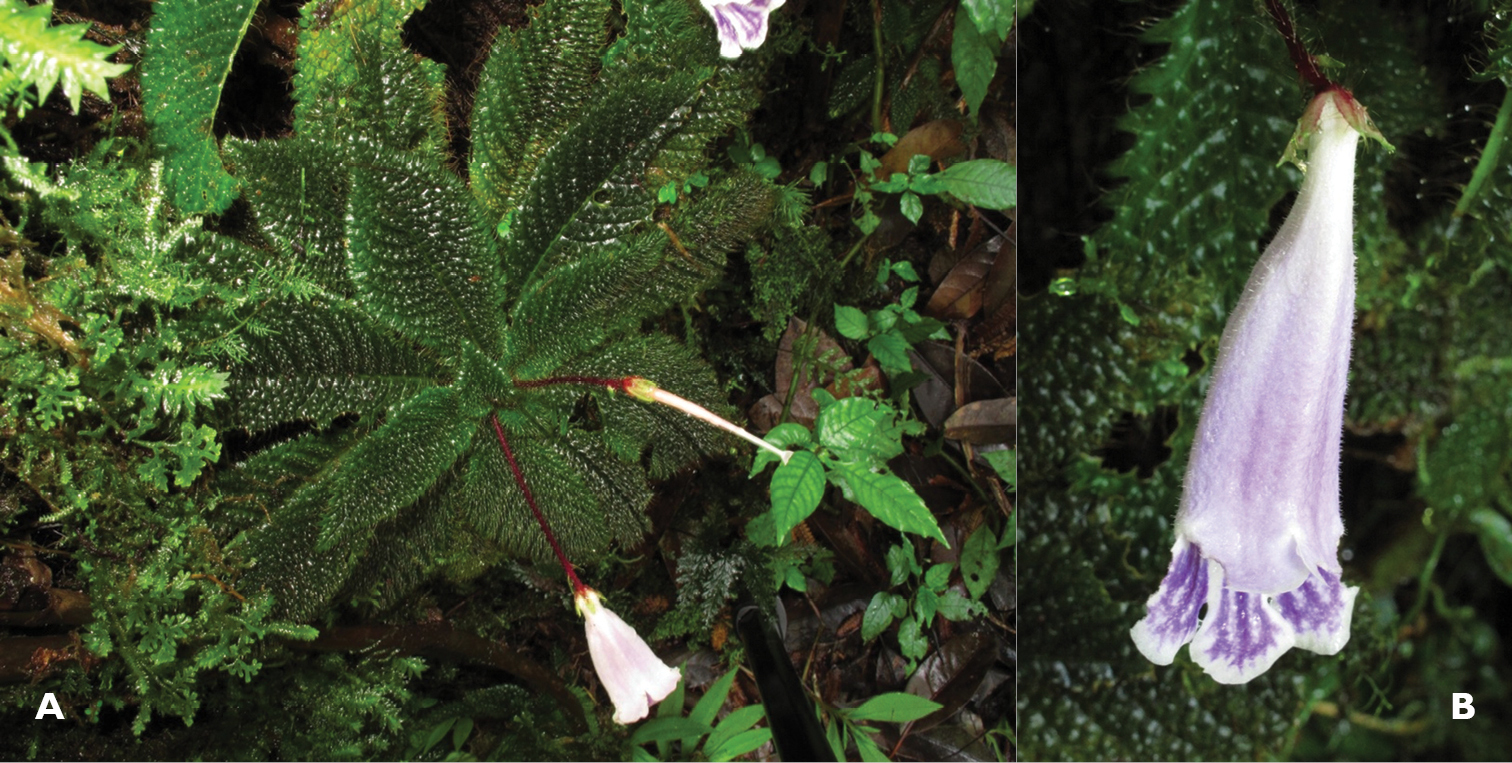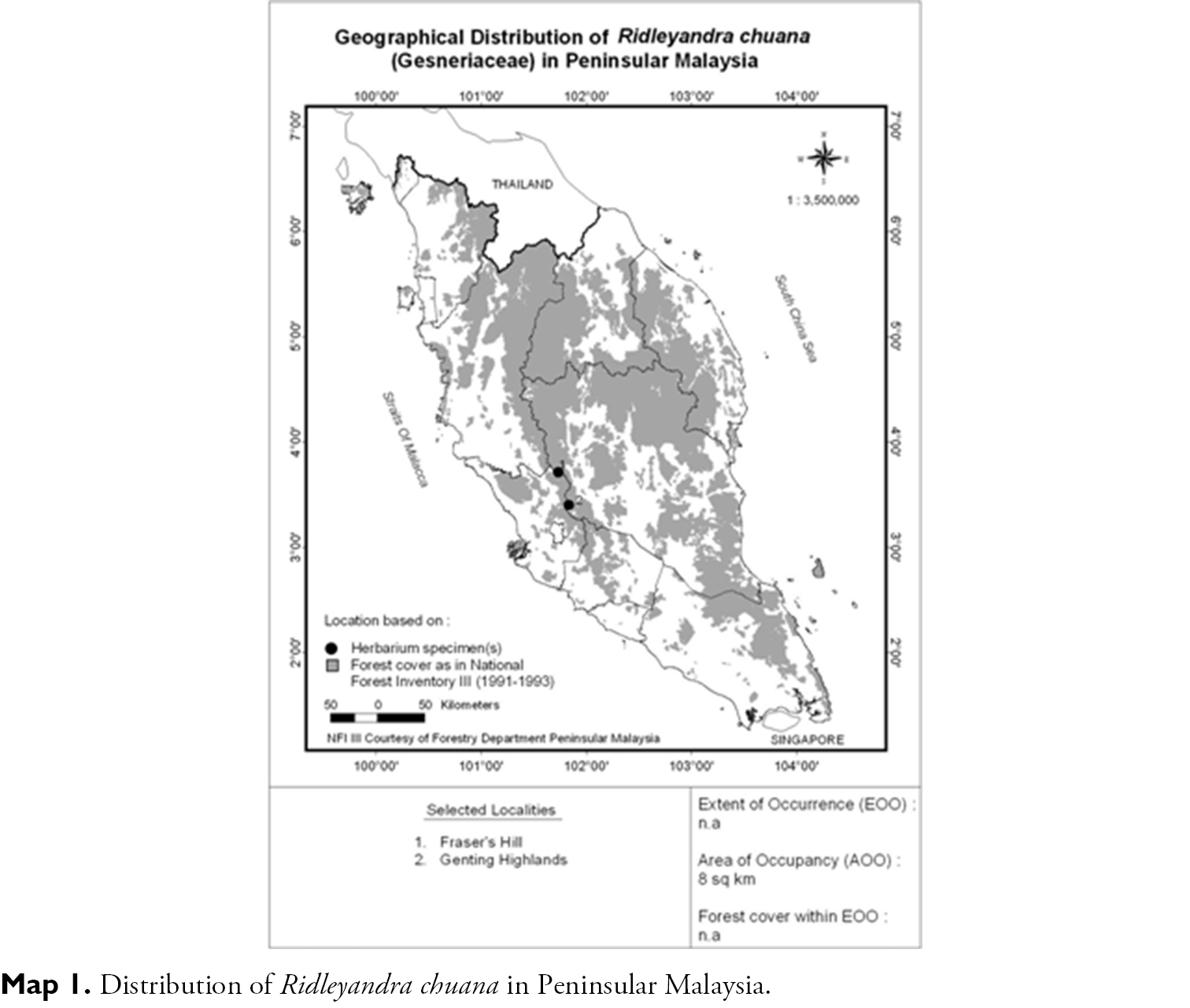






(C) 2013 Ruth Kiew. This is an open access article distributed under the terms of the Creative Commons Attribution License 3.0 (CC-BY), which permits unrestricted use, distribution, and reproduction in any medium, provided the original author and source are credited.
For reference, use of the paginated PDF or printed version of this article is recommended.
Citation: Kiew E (2013) Ridleyandra chuana (Gesneriaceae), a new species from Peninsular Malaysia. PhytoKeys 25: 15–19. doi: 10.3897/phytokeys.25.5178
Ridleyandra chuana, a new species of Gesneriaceae, is described and illustrated. It is endemic in Peninsular Malaysia and known from two small and restricted populations in montane forest. Its conservation status is assessed as vulnerable.
Ridleyandra chuana, Gesneriaceae, Peninsular Malaysia, endemic, conservation
This species was first encountered in 1932 at Fraser’s Hill, Pahang. However, it was only in 1999 when another population was discovered by L.S.L. Chua on Gunung Ulu Kali, Pahang, that sufficient material was available for its description. Since then both these localities have been revisited and the Gunung Ulu Kali population is now the focus of conservation. This species is unusual in Ridleyandra in occupying a very narrow niche, which probably contributes to its rarity and small population size. This is clearly seen at the Fraser’s Hill locality where a small population of less than 30 plants is confined to a small area where moss-covered granite rock just emerges above the soil surface but is absent from the surrounded area of soil where Codonoboea curtisii (Ridl.) C.L.Lim (Gesneriaceae) is plentiful.
It is a distinctive species among Ridleyandra species in its mammillate leaf surface with hairs on raised conical bases. Indeed, when sterile with its dark green leaves it more resembles Codonoboea crinita (Jack) C.L.Lim than Ridleyandra atrocyanea (Ridl.) A.Weber, the only other Ridleyandra species with a mammillate leaf surface. Two species, Ridleyandra kelantanensis Kiew and Ridleyandra longisepala (Ridl.) A.Weber, have similar white corollas with purple lines and toothed leaves. In fact
urn:lsid:ipni.org:names:77129808-1
http://species-id.net/wiki/Ridleyandra_chuana
Figure 1In its leaf surface with mammillate hairs and its narrowly lanceolate bracts, Ridleyandra chuana resembles Ridleyandra atrocyanea (Ridl.) A.Weber but it differs in its shorter peduncles 6–8.5 cm long (not 8–12 cm), pedicels 5–7 mm long (not 10 mm) and its shorter 3–5 cm long white corolla with purple lines (not purple-black and 5–7 cm long). In flower colour and pattern it is similar to Ridleyandra kelantanensis Kiew but differs not only in its mammillate leaf surface but also in its longer petioles (2.3–3 cm long not 1–1.75 cm in Ridleyandra kelantanensis), smaller teeth on the leaf margin (2.5–3 × 1.5–3 mm not 4–5 × 3.5 mm), larger bracts (4–6 mm long not 2–3 mm), and corollas with a much narrower lip ca 13 mm wide (not 24 mm wide).
Peninsular Malaysia. Pahang: Gunung Ulu Kali, 27 Jan 1999 (fl.) LSL Chua FRI 40758 (holotype: KEP!; isotype: KEP!).
Perennial herb. Stem woody, usually unbranched, rarely 2-branched, erect, 12–19 cm tall, 3–5 mm diam., upper part of stem, petiole, leaf margin, lower surface of veins, peduncle and pedicel and sepals hispid; hairs reddish brown, dense, unbranched, multiseriate, ca. 2 mm long and on the margin and veins 3–4 mm long. Leaves in unequal pairs clustered in a rosette at the top of the stem, lowermost to 7 mm apart, deep green above, whitish green beneath; subsessile or lower leaves with petiole 2.3–3 cm long, ca. 6 mm diameter; lamina oblanceolate, 11–12.5(–14.5) × 2.7–4.5 cm, narrowed to base, margin serrate, teeth tip rounded, 2–3 × 1.5–3 mm, towards the base teeth divided almost to midrib, 5–9 × 2.5–4.5 mm, apex acute to acuminate, above hairs dense, surface mammillate with hairs raised on narrow cones, minutely punctate beneath; midrib impressed above, prominent beneath, lateral veins 17–18 pairs. Inflorescence 1-flowered, rarely 2-flowered then flowers open in succession, peduncle 6–8.5 cm long, dark maroon-purple, slightly curved upward; bract pair pale green, positioned 5–10 mm below the calyx, narrowly lanceolate, 4–6 × 0.75–2 mm, pedicel dark maroon-purple, 5–7 mm long. Flowers with sepals divided to base, dull purple or pale green with a red midrib, lanceolate, 4–7.5 × 1.5–2.5 mm, hispid; corolla funnel-shaped, 3–4 cm to tip of lower lip, tube 2–3 cm long, ca. 2 mm diam. at base dilating to 10 mm at the mouth, outside minutely pubescent, white at the base becoming tinged purple at the tube dilates, inside white with mauve or purple lines with 3 lines extending into each of the three lobes where they spread and coalesce leaving a white margin around each lobe, lobes projecting ca 10 mm beyond the tube, lateral lobes ca. 4 × 5 mm and the centre lobe ca. 5 × 6 mm; stamens 4 in 2 pairs, filaments white, lower pair ca. 23 mm long, upper pair ca. 26 mm long, anthers creamy white, ca 1 mm long, joined in pairs, staminode ca. 3 mm long; nectary annular, ca. 1 mm high; ovary ca. 3 cm long, pale mauve, stigma white, broadly spathulate, ca. 2 × 1.5 mm long, apex emarginated. Capsules glossy, deep purple, slightly curved upward, glabrous, 5–6.5 cm long, 2.5–4 mm diam., sepals persistent and clasping the base.
Ridleyandra chuana Kiew. A habit B flower.
Endemic in Peninsular Malaysia, Pahang (Fraser’s Hill and Gunung Uli Kali) (Map 1).
Distribution of Ridleyandra chuana in Peninsular Malaysia.
On moss-covered granite rock embedded in soil or on low moss-covered granite boulders, in extremely damp, deeply shaded conditions on steep slopes in valleys. One population occurs in lower montane forest at 1250 m and the other in upper montane forest at–1570 m.
Named in honour of Dr Lillian Swee Lian Chua, botanist and conservationist, who first discovered this species on Gunung Kali while making an ecological inventory of the summit flora (
EN B2ab(ii, iii). Following the 2001 IUCN Red List Categories and Criteria, (
Pahang: Gunung Ulu Kali–26 Nov 2007 LSL Chua & R Kiew FRI 46936 (KEP!); Fraser’s Hill– 4 Nov 1932 EJH Corner s.n. (SING!), 16 Aug 1937 EJH Corner s.n. (SING!), 18 Nov 2007 MY Chew et al. FRI 53772 (KEP!), 24 Feb 2008 R Kiew RK 5412 (KEP!).
Plants in both populations are identical in all characters except for sepal length (6.5–7.5 mm in the Ulu Kali population and ca. 4 mm in the Fraser’s Hill population).
In both the original collections (Chua FRI 40758 and Corner s.n. 1932) only a single flowering specimen was collected suggesting that this is not a free-flowering species. Monitoring over a longer period by JPC Tan suggests that there is a low level of flowering throughout the year with periodic bursts of more intense flowering. This same pattern is seen in some species of Codonoboea, such as Codonoboea platypus (C.B.Clarke) C.L.Lim (
This study was carried out as part of the Flora of Peninsular Malaysia Project funded by the Ministry of Science, Technology and Innovation through the National Council for Scientific Research and Development under Project No. 01-04-01-000 Khas 2 entitled “Safeguarding the Forest Plant Diversity of Peninsular Malaysia” and the 10th Malaysia Plan Development Project entitled “Dokumentasi dan Inventori Flora Malaysia”. I am indebted to LSL Chua for showing me the Genting Highland site, Chew MY and Lim CL for accompanying me to refind the Fraser’s Hill population, to MY Siti-Munirah for preparing the conservation status, to JPC Tan for spear-heading the project to conserve the Gunung Ulu Kali population, to LSL Chua for permission to reproduce her photographs and to the curators and staff of the BM, E, K, KLU, L and SING herbaria for permission to examine specimens in their care.

